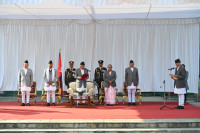National
Most Valley vehicles spew smoke well above limit
A recent monitoring drive launched by government agencies to check vehicle emission levels has found nearly half them plying the Capital streets are not complying with the national standard.
Chandan Kumar Mandal
A recent monitoring drive launched by government agencies to check vehicle emission levels has found nearly half them plying the Capital streets are not complying with the national standard.
A joint team from the Department of Environment (DoE), the Department of Transport Management (DoTM) and the Metropolitan Traffic Police Davison (MTPD) is carrying out vehicle emission test in different parts of the Capital.
On Thursday afternoon, of the 32 vehicles (17 diesel-run vehicles and 15 petrol-run vehicles) put under test at the Bhadrakali, 14 (10 diesel-run and 4 petrol-run) vehicles were found to be exceeding the emission level set by the government, according to Umesh Ranjitkar, spokesperson for the MTPD.
Most of them were public vehicles.
Seven taxis, eight private cars, eight micro-buses, five public buses, two private, one government jeep and one private pick-up van were tested for their emission levels on Thursday, said Ranjitkar. They were randomly picked for the test by the monitoring team as they were emitting comparatively more black smoke.
Vehicle emission and smoke from brick kilns have been said to be the main sources of air pollution inside Kathmandu Valley.
“The random test shows vehicles in the Valley in the same ratio, mostly public vehicles, are likely to fail emission test if we put all the vehicles plying the Capital roads are tested,” said Ranjitkar.
According to Ashish Gajurel, a transport and traffic engineer, public vehicles generally have higher emission because their owners do not pay proper attention to regular maintenance.
“Private vehicles owners usually maintain their vehicles on a regular basis,” said Gajurel, adding that such emission tests should be carried out more frequently.
Petrol-run vehicles, manufactured before and after 1980, should not produce carbon monoxide (CO) more than 4.5 per cent and 3.5 per cent respectively in its total smoke density as per the national standard.
Likewise, CO emission of diesel-run vehicles, which are manufactured in the same period, should not cross more than 75 per cent and 65 per cent under Hartridge Smoke Unit (HSU)
The vehicle emission test by the joint team follows the government’s recent announcement to set up “Quick Action Team” (QAT) to deal with pollution crisis
in the Valley.
The QAT comprises various government agencies.
The joint monitoring team started emission test on Wednesday from Singh Durbar where government vehicles were checked for their emission levels. The team had checked nearly 30 vehicles. Most of them had successfully passed the test.
According to Ranjitkar, the emission test drive will continue in different parts of the city in coming days.
However, the team is facing problems in operating the emission testing machine. The one currently being used by the team belongs to the Department of Environment and it needs electricity to run. So, the team can check vehicles in those areas only where they can easily power the machine.
“We have only three emission testing machines fixed at three different areas. The one we are using is portable but it needs electricity. We had to borrow electricity from a nearby restaurant,” said Ranjitkar.
Those vehicles which failed the emission test recently, however, have not faced any action. “We just wanted to send a message that the owners should maintain their vehicles regularly,” said Ranjitkar, adding that if they fail to pay heed, they will be face fines.
Engineer Gajurel, however, insisted that the country ultimately must adopt policies that promote electricity vehicles.




 19.12°C Kathmandu
19.12°C Kathmandu















